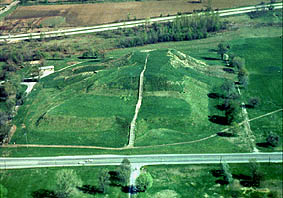
Monks Mound - a monument to surplus and wealth accumulation.
At the household level production of a food surplus is promoted by the biological benefits it confers on the family. Familys that have a surplus tend to be better fed, have better health, and a greater ability to survive temporary harvest shortfalls. Still, all food surplus cannot (either because the amount is too much to be eaten before rotting, or because of social prescriptions) be consumed by the household. Thus, a surplus provides the means for obtaining non-perishable goods. These goods can then be used to curry favour, pay for services, or "pay" for other foods. As such, prestige items are a shorthand way of communicating wealth. Community feasting may be another way of disposing of a portion of the surplus. Both community and individual status may be acquired through feasting.
A chief or other important person can moblize a portion of this surplus both for their own purposes as well as those that benefit the community. To acquire the surplus of other's labor, the chief manipulates the perceived religious and social obligations defined by the society's world view. Ostensibly, a chief uses religious beliefs and world view to motivate or obligate surplus labor (created by easily stored surplus food that buys time for non-subsistence activities) for religious or civic work such as mound building, clearing of the chief's fields, or serving in a war party.
Consequently, chiefs try to support activities that encourage production of surplus. For the Mississippian elite, these efforts may have included land clearing, construction of ridged fields, and acquisition of more land for their family. Multiple lines of archaeological evidence indicate substantial food and labor surpluses in American Bottom Mississippian society. These include large storage pits, increase in population, craft specialization, mound construction, and a decrease in the amount of communally owned property with a concomitant increase in household property rights. In effect, the cost to commoner households for their increasing economic autonomy was diversion of some foods and materials to the elite.